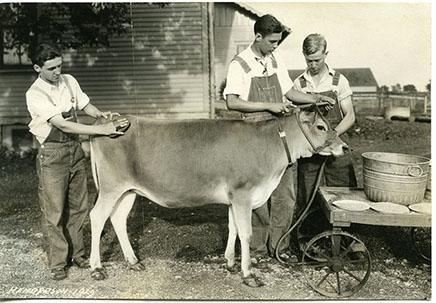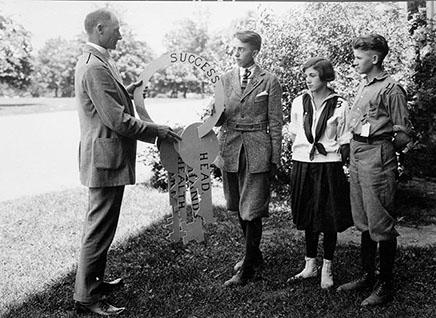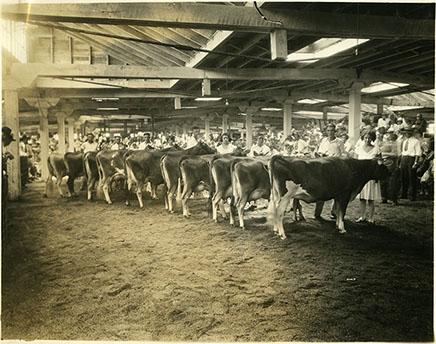Celebrating KY 4-H History in the 1920s
The Second Decade
The Thrust
Already organized as one entity and under the direction of one leader, the second decade of 4-H (still called Junior Agricultural Clubs at that time) began with a strong effort to increase enrollment. The year 1918 saw 3,887 boys and girls enrolled in 12 projects, mostly agricultural in nature. In 1920, Governor Edwin P. Morrow proclaimed the week of December 6-11 as Junior Club Enrollment Week, and teachers were encouraged to support the enrollment effort. By the year’s end, 20,079 members (13,705 boys and 6,374 girls) were enrolled. This number included 240 black boys and 219 black girls.

Black members at this time were called “Farm Makers.” In 1920-21 there were four clubs for Farm Makers in four counties, and they were supervised by black agents. According to Smith, the year when white agents began organizing clubs for blacks is not known, but records show that some agents did so by 1938.
The immediate result of the increased enrollment was a drop in the number of projects completed. Up to this time agents had worked with each member individually and project completion was high. Members had pursued a specific project such as corn, pigs or canning. With the increased enrollment came a new direction—the organization of community clubs, with the goal being the development of the total youth. Local clubs were set up with year-round programs, including demonstrations and recreation. The clubs were organized with officers, members and committees and conducted using parliamentary procedure.
Now that parents and other volunteer adults also provided leadership, project completion figures graduallyincreased. In 1923, only 46 percent of those enrolled completed projects; by 1927 completion had risen to 70 percent and by 1932 to 82.5 percent. By the end of 1929, enrollment in Junior Clubs was 21,592 (5,020 greater than 1928).The community clubs method increased the range of activities for members and included more demonstrations—some of these being adult leader demonstrations—and judging activities, as well as recreational activities.
Printed Materials for 4-H
Junior Club work remained a high priority for the University of Kentucky, College of Agriculture Extension Division. During the decade of the twenties, much of the written effort of the faculty was directed toward publications for club members and leaders. For example: Circular No. 103, Swine Fattening Project—Junior Agricultural Clubs, May 1921; Circular No. 106, Baby Beef Project—Junior Agricultural Clubs, May 1921; Circular No. 112, Beginning Clothing Project—Junior Agricultural Clubs, December 1921; Circular No.114—Beef Breeding Project—Junior Agricultural Clubs, January 1922; Circular No. 116—Elementary Clothing Project; Circular No. 195—Junior Home Projects in Clothing; Circular No. 189—Junior Food Project Programs I, II, and III. There also were circulars on topics such as butter-making, dairy heifer and calf projects and many others related to agriculture and home economics.
Of particular interest were manuals on organizing and directing Junior Agricultural Clubs. In March 1921 Anita Burnam and Millard Hall wrote Circular No. 91, Hints on Programs for Junior Agricultural Clubs. In January 1922, Carl W. Buckler, State Leader of Junior Clubs wrote Circular No. 117, A Manual on Junior Agricultural Clubs. In reading some of these circulars, it is clear that those early leaders were insightful and highly motivated. In fact, except for an occasional archaic spelling, the principles on which they based their hints are as valid today as in 1921.
Duties of the Leader
Successful leadership embodies a vision of the objective, a knowledge of details, and an attractive personality. The ability to see the opportunities of club work is the first requisite of a club leader. He/she must learn not only the resources but also the limitations of his community. He must use methods that will develop these resources and remedy the weaknesses, thus giving the club members an insight into a richer and fuller life.
The leader should outline a definite program. This will give greater efficiency by serving as a guide for activities. The first of the year the leader and the program committee should plan a program for each meeting to be held during the year. These programs should be made attractive to the club members. Anything they cannot appreciate will fail. A real leader understands the members’ point of view and directs their thinking to worthwhile matters. An important essential of a club leader is the ability to get boys and girls to hold their own meetings. Often a long time is required to awaken people. This however, is the duty of the club leader. Enthusiasm is the life of an organization. Boys and girls respond to enthusiasm quicker than the adult. Therefore, the club leader should not only have enthusiasm, but be able to communicate it to the club members. Strive to get action, this appeals to youth. After securing this, it remains for the club leader to direct the energy of the young life into constructive channels to the end that an efficient member of society is developed.1
The printed publications were of high quality in terms of print, paper used, and instructional illustrations. The authors included photographs of members and activities and produced altogether first-class printed pieces.
In looking at circulars and photographs of members, the emphasis on personal appearance is striking. Members generally appeared, if not in uniform, at least in white shirts and ties or some type of specified dress. The photograph below shows the typical uniform of canning club members.
Camping
While the State Fair provided a camp setting for boys who participated in the fair as early as 1912, camping as a statewide activity actually began in 1920 when Laurel County camped 38 boys and 44 girls, and Daviess County camped 61 boys and 43 girls. The camping idea quickly took root, and in 1921 there were 22 county camps held Monday through Friday on school grounds, cemetery lots, fairgrounds and anywhere space could be found. During this year, 1,793 youth and 106 adult volunteer leaders participated in camps in Ballard, McCracken, Graves, Union, Henderson, Daviess, Nelson, Muhlenberg, Christian, Warren, Barren, Hart, Laurel, Lee, Knott, Perry, Breathitt, Morgan, Owsley, Powell, Lawrence and Boyd counties. There were 6,890 visitors at these camps, according to the records.
The idea of district camps began in 1929 when there were 12 such camps throughout Kentucky involving 90 counties, 977 boys and 1,123 girls and 252 volunteer leaders. Visitors still were interested in the camps and 7,785 of them visited these district camps. Thursday nights were designated for parents’ visitation night and a chicken dinner was prepared for campers and visitors on this night.
Only in reading back into the early records of Extension and 4-H can one appreciate the quality of excellent, detailed planning that went into 4-H work—particularly the planning of these camps. The following pages were taken directly from Circular No. 117, A Manual on Junior Agricultural Clubs Link
More…
More 4-H Activities
Early 4-H members had numerous exciting possibilities for activities related to their total development. In addition to the new camping program of the twenties, it was in this decade that members began exhibiting projects at county and national fairs and shows. They also had opportunities to participate on judging or demonstration teams and attend Junior Week at the University of Kentucky, National 4-H Congress in Chicago and National 4-H Camp in Washington, D.C.

Junior Week—Junior Week (known later as Teen Conference) began in 1921, June 20-25. It was held at the University of Kentucky in lieu of the boys’ encampment that had been held at the State Fair. The State Fair Board contributed $600 toward holding this new Junior Week for both boys and girls. The enrollment in 1921 was 130; it grew to 513 in 1927.
Then, as now, the private sector provided financial support to 4-H. The “4-H Bible,” the ragged, bound version of old 4-H records as fondly referred to by 4-H state staff, contains records of the donors and the amounts they contributed to Junior Week.
Stock Shows—The first 4-H lamb show and sale was held July 15, 1924, at the Bourbon Stock Yards in Louisville. Club members entered 1,044 lambs. Swine shows soon followed.
National 4-H Club Congress—Kentucky 4-H members began participating in this event in either 1923 or 1924. The records are not clear on this although free trips to the International Livestock Show in Chicago were planned and a mention was made of attendance at the Congress, which was held at the same time.
National 4-H Club Camp—Held in Washington, D.C. Kentucky sent its first allotted four delegates to the second annual camp in 1928. This event became a coveted honor for 4-H members.

The University Scholarship Club—The 4-H program proved to be an important link between the College of Agriculture and farm youth. In 1929, there were 265 members of the University Scholarship Club. These were students who contributed at least $5.00 to a fund which would give a $100 scholarship to a 4-H club member who wanted to enter the university. Thirty-seven percent of all College of Agriculture students had been 4-H members.
The 4-H Pledge and Motto
The twenties proved to be a vintage decade for 4-H in terms of fleshing out a well-conceived idea for youth development. The program grew in numbers and in commitment to developing the total youth.
This commitment to total youth development found expression in the 4-H Pledge. The pledge was written by Otis Hall, chairman of the first National 4-H Camp Congress, and submitted at the first Congress in 1927.
I pledge
My HEAD to clearer thinking,
My HEART to greater loyalty,
My HANDS to larger service, and
My HEALTH to better living
For my club, my community, and my country.
The pledge was changed to include “my world” in 1973.
At the same Congress, the 4-H Motto was presented by Miss Carrie Harrison, botanist in the Bureau of Plant Industry. The motto, which speaks so well for the 4-H commitment to excellence, is still embraced today—To Make the Best Better!
4-H Songs
Two songs that found their place in Kentucky 4-H are representative of the goals of the early, rural 4-H program.
Dreaming
By Fannie R. Buchanan and Rena M. Parish, 1929
My home must have a high tree,
Above its open gate;
My home must have a garden
Where little dreamings wait;
My home must have a wide view
Of field and meadow fair.
Of distant hill, of open sky,
With sunlight everywhere.
My home must have a friendship,
With every happy thing;
My home must offer comfort
For any sorrowing;
And every heart that enters,
Shall hear its music there,
And find some simple beauty,
That every life may share.
My home must have its mother,
May I grow sweet and wise;
My home must have its father,
With honor in his eyes;
My home must have its children;
God grant the parents grace,
To keep our home through all the years,
A kindly, happy place.
Plowing Song
By Fannie R. Buchanan and Rena M. Parish, 1929
A growing day and a waking field,
And a furrow straight and long,
A golden sun and a lifting breeze,
And we follow with a song.
A guiding thought and a skillful hand,
And a plant’s young leaf unfurled,
A summer’s sun and a summer’s rain,
and we harvest for the world.
Sons of the soil are we,
Lads of the field and flock,
Turning our sods, asking no odds,
Where is a life so free?
Sons of the soil are we,
Men of the coming years
Facing the dawn, brain ruling brawn,
Lords of our lands we’ll be.
